EB Field Consultant Report Revisited

Readers may recall that this blog was the first to provide a leaked version of the consultant's report on Enforcement Bureau field activities that was used to rationalize decimating this organization and reducing it to 54 staffers nationwide.
In this case, the provider acquired another Alaskan telecommunications company’s cell towers in mid-2013, at which time it conducted an internal inventory of its cell towers. The provider found that 118 cell towers, including many of the recently acquired towers, were not registered in the ASR system in violation of the FCC’s Rules. It also concluded that three of its towers were not properly lit. The company self-reported the apparent violations to the FCC in early 2014, and thereafter began a complete review of its towers.
The provider settled the FCC’s subsequent investigation into the tower violations with a hefty $620,500 payment. In addition, the provider agreed to complete the tower review it commenced in 2014 and to bring all of its towers into compliance by April 30, 2016.
(The low key hidden press release on the fine is here and the more detailed Consent Decree and Order are here)
With the downsizing of the EB field staff and the reducing of field locations from 24 to 13 nationwide towers owners in most of the country can be assured that the likelihood of an inspection or even being noticed by FCC agents traveling outside their office has been reduced to near zero. The report claimed that FAA was consulted. Did they talk to the FAA staff that deals with spectrum management only or did they also speak to the FAA staff responsible for airspace obstruction marking and lighting? Like or not, §303(q) makes FCC responsible for marking and lighting of antennas that intrude into navigable airspace.
It is actually amazing that aviation organizations such as the usually shrill Aircraft Owners and Pilots Association ("Protecting Your Freedom to Fly" although in the case of FCC it is usually protecting the right of AOPA members to have all aircraft radios grandfathered from new rules for higher spectrum efficiency"), Airlines for America, and Helicopter Association International were silent about the field downsizing that will directly affect aviation safety.
In drafting this blog entry I noticed something else strange about the package of leaked documents that included the consultant's report. It also included a memo from EB Chief LeBlanc to the EB field staff dated March 10, 2015. (pdf p. 4-5 of this package.) In that memo was the following statement:

EDG is the field unit based in suburban Atlanta that designs and build receiver and direction finding equipment for field operations including the custom made covert direction finding cars FCC agents use. It also designs and maintains the HF direction finding equipment used by the FCC's Public Safety and Homeland Security Bureau that is rarely mentioned. But as we have said in a previous post "The Equipment Development Group in Powder Springs, GA shrinks from 10 positions to 7." So how is EDG going to be able to handle these new functions with a smaller staff?
UPDATE
The EB homepage now has another antenna marking/lighting violation posted, unlike the Alaskan one described above that is hidden somewhere in the bowels of the website. This new one was released on November 3 and deals with Johnson Towers Corp., "an owner-operated company with no employees and three antenna towers" in Pinellas Park, Florida. This action follows an NAL issued in November 2013:
"In response to the NAL, JTC asserted that insufficient finances and lawsuits hindered its ability to install lighting systems on antenna structures 1060088 and 1060090, acknowledged that it did not notify the Commission about the dismantlement of antenna structure 1060089,and stated it would come into compliance as quickly as possible."
Did EB's "Field Modernization" consultant know about this action when he concluded that there was "a high degree of compliance" in tower compliance? Was FCC leadership aware of this as they agreed to implement the report's recommendations? The importance of this issue is clearly stated in the new order: "Critically, conformance with the lighting requirements imposed by the Commission and the FAA ensures that antenna structures do not pose a public safety risk to passing aircraft." Thus tower lighting and marking is a safety of life issue even though it appears to be one of EB's lowest priorities.
The NAL describes how this incident was brought to the FCC's attention by FAA who noticed a paperwork issue. An agent from EB's Tampa office visited the Pinellas Park site and noticed the unauthorized demolition and the lack of lighting on the remaining towers. Now it is only 20 miles from Tampa to Pinellas Park so this was an FAA inquiry that was easy to followup. But post-"Field Modernization" most of the USA will be more than 100 miles from the remaining 13 offices. How are tower lighting and marking rules of Part 17 going to be enforced in this new era? When the broadcasters complained about pirate enforcement issues, EB announced they would develop a plan - not yet finished. How will the downsized EB field organization deal with safety related tower enforcement.
Also, why did it take 2 years and 2 days to resolve an enforcement issue related to a safety of life topic? (Actually 2 years and 5 months if you start from the originally inquiry from FAA on April 14, 2011.)
Of course, another issue is why doesn't the aviation community care? AOPA has traditionally been a total nuisance at FCC trying to avoid having their member spend money to upgrade avionics to meet new spectrum efficiency standards. Don't the lives of their members, as well as the public, matter as much as the wallets of their general aviation aircraft-owning members?
Demise of FCC Form 740 Along with the Rest of Spectrum Enforcement
October 19, 2015 - Order
FCC Form 740 Suspension Order
For those of you not familiar with the Form 740, it is the form needed to import electronics equipment that is FCC-regulated, or potentially FCC-regulated, into the USA. Below is a key section of the form: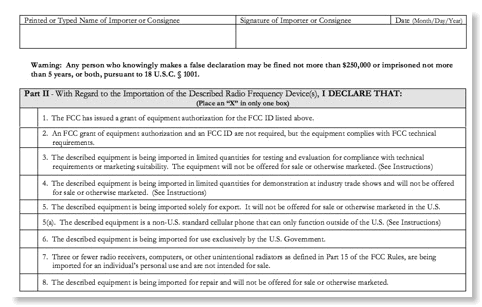
Part of present Form 740
Note that the importer or consignee has to certify subject to criminal penalties that the items have been issued a grant of equipment authorization. In view of the recent VW kerfuffle perhaps FCC should up the ante and require a statement both that there is a grant and that the equipment has hardware and software that is consistent, within normal commercial practices, with what was approved by FCC - which is most cases was actually a TCB operating on behalf of FCC.
FCC had previously proposed to delete the Form 740 filing requirements in the NPRM of Docket 15-170 stating (at para. 119)
We also question whether the Form 740 requirement continues to be useful for us to identify non-compliant RF devices and take appropriate follow-up action. The continuation of the burden of filing Form 740 no longer appears justified and we propose to eliminate the requirement. We seek comment on this conclusion and the observations on which it is based. Parties are invited to identify any benefits we could derive by continuing to collect the Form 740 information, in its current form or a modified form, and specifically to comment on whether and how any of the underlying objectives of our equipment authorization program would go unmet if we eliminate our existing means of collecting this data.
While the form may not allow ready identification of "non-compliant equipment", the threat of criminal prosecution under 18 USC § 1001 might be a real deterrent to such importation if FCC really cared about spectrum enforcement. But as we have written recently there are serious questions whether FCC cares about any type of spectrum enforcement.
Recall the chart from the consultant's report used to justify spectrum enforcement downsizing that we have used several time before:
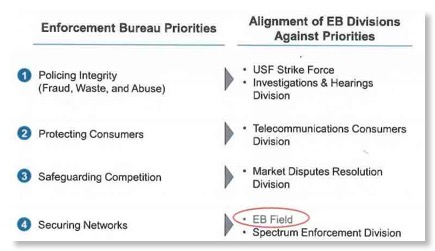
Spectrum seems to be EB's lowest priority. And what little interest they have seems to be ex post facto enforcement of public safety interference, with maybe a little time for broadcast pirates. Ex ante enforcement of equipment marketing has been low on both OET's and EB's agenda for more than a decade.
Now Marcus Spectrum Solutions LLC does not own any Title III radio licenses, let alone ones that are worth billions of dollars. But since the fair market price of spectrum is in the range of $0.50 - $2/MHz-pop there certain are firms - and maybe even individuals - who own billions of dollars worth of licenses. But if I was responsible for such licenses and accountable to shareholders I would be very nervous about the sudden demise of the Form 740 along with FCC's ever shrinking interest in all spectrum enforcement.
The Report and Order in Docket 13-44 had some improvements related to enforcement and post-market samples: it allowed for some FCC involvement in TCB sampling of production units (para. 27), but it still limits sampling to 5% and does not address purchasing units at the retail level where they can not be tampered with as in the case of "lab queens"/"golden apples" that are selected for testing because of superior performance or possibly even modification à la VW emission tests. It also requires that TCBs only test units made by their own clients - a certain conflict of interest.
So given FCC decreasing interest in spectrum enforcement, the new 740 Order should be no surprise, but maybe the major spectrum licensees as well as legitimate manufacturers of radio equipment should challenge it forcefully?
As Docket 13-111 Lingers Without Resolution, Comm. Pai Tries to Focus Attention on Prison/Cell Phone Crisis
Sobering meeting w/ corrections officials at Georgia prison about serious, growing problem of contraband cellphones. pic.twitter.com/Xbw3SRBCjm
— Ajit Pai (@AjitPaiFCC) October 16, 2015FCC Commissioner @AjitPaiFCC visited Georgia today to learn about the problem of cellphones in prisons. http://t.co/xI9eZq4c79 (from @AP)
— Kate Brumback (@katebrumback) October 15, 2015.@GA_Corrections: on pace to confiscate >8K contraband cellphones this year. Used to place hits, run scams, more. http://t.co/z8Ks8wgqq6
— Ajit Pai (@AjitPaiFCC) October 16, 2015Long time readers will recall that the issue of contraband cell phone use in prisons and countermeasures for dealing with them have been a recurring topic here, even if it is one that the cellular industry thinks should be buried. In general, communication should enhance life and usually does. But large scale use of contraband phones by incarcerated criminals actually threatens life!
Independent FCC action, championed by Comm. Clyburn, has reduced the cost of authorized legitimate pay phone services from prisoners to their families and has somewhat decreased the demand for contraband phones. On May 1, 2013, FCC released the NPRM in Docket 13-111 "to facilitate the development of multiple technological solutions to combat the use of contraband wireless devices in correctional facilities nationwide." This was almost 4 years after the filing of a petition for rulemaking by the South Carolina Department of Corrections and dozens of other state and local corrections agencies that apparently was consigned the FCC's secret petition black hole where it lingered in a corner of ECFS that was unknown to all but a few FCC insiders!
But as the cellular industry demands major changes for US spectrum policy to satisfy their endless appetite for spectrum below 6 GHz - they have only token interest in higher frequencies as can be seen in their minimal comments to FCC and participation in WRC preparation related to higher bands - as the cellular industry demands the lion's share of FCC's ever shrinking resources, they seem to have little or no interest in dealing decisively with this deadly unintended consequence of their present services. They have sent the underfunded and understaffed state and local prison administrators on a quixotic chase of the "holy grail": "managed access" which will solve the technical problem of illicit cellphone use in prisons with zero impact on the carriers' business plans. Indeed, they deny that this will result in any over coverage while at the same time insist that jamming will always results in over coverage. WOW - responsive physics!
In their most recent ex parte meeting with FCC staff in December, CTIA and carrier representatives pressed for "the need for a court order to terminate service to a contraband device" presumably under all circumstances including prisons in remote areas. Contrast this with the views of the American Corrections Association which ask to simplify the disconnect process, require carrier participation in managed access system if requested by prisons, and allow jamming in the location where it is technically possible due to remote locations.
But meanwhile nothing is being resolved at FCC in this life or death matter. Kudos to Comm. Pai for making an onsite visit to learn about the problem. We hope that FCC's delays in this urgent matter, now that 6 years have passed since the South Carolina petition, will soon end.
#IdeasForRandall
Or you can email all great ideas to me! I’ll take them on Twitter too! Just tag me with your idea & #IdeasForRandall http://t.co/uXenMnBfdv
— John Legere (@JohnLegere) October 13, 2015In the above tweet, T-Mo, "the Un-carrier" asks for comments on what is wrong with the industry. Perhaps we should all tell him that while the cellular industry has made many great contributions to US economic growth and US society, it has persistent blind spots with several unintended consequences of their actions and business plans.

In response to a Tuesday morning report from the LA Times that an AT&T customer’s service improvement suggestions were met with a letter from the carrier’s lawyers, T-Mobile is encouraging customers from any wireless carrier to share their thoughts with the Un-carrier.
As of today, T-Mobile said wireless subscribers across the board are welcome to send their ideas for improving the industry to IdeasforRandall@t-mobile.com or share them with CEO John Legere on Twitter using the tag #IdeasforRandall. In its typical provocative style, T-Mobile said it will take action on the best ideas before forwarding them on to AT&T CEO Randall Stephenson and AT&T’s lawyers.
According to Legere, AT&T’s harsh response to Alfred Valrie, the longtime customer cited in the LA Times article, proves that AT&T and its CEO “don’t care about what customers want. AT ALL.” According to the LA Times report, Valrie received a warning letter from AT&T's lawyers after he emailed Stephenson suggesting the carrier offer "unlimited data for DSL users and 1,000 text messages for $10 a month."
“The entire Un-carrier revolution began by listening to customers,” Legere said in a Tuesday press release. “It’s where we get our best ideas, and I want everyone to keep sending them my way at John.Legere@T-Mobile.com. It absolutely amazes me that Randall would tell a lifelong customer to basically go away and talk to my lawyers. I interact with customers on a daily basis so I can hear their ideas firsthand. It’s called living in the 21st century.”
So, Mr. Legere, here are some ideas for your company and the industry to think about:
- The list of 7 New Year's resolutions I first posted in December 2011. These deal with: Wireless technology innovation, Social harmony and cell phone use,Cell phones use in vehicles, RF safety, Base stations and their environments, “Spectrum scoring” or “How to count to 500”, Provide communications for niche applications that otherwise contend for spectrum with CMRS, & Unrestrained use of anonymous prepaid cell phones. I don't see any progress or even industry interest in any of these topics.
- The lack of US cellular industry interest in 5G above 24 GHz. T-Mo filed comments in Docket 14-177 that were pretty useless and then didn't even file reply comments. How many of the 176 questions in the NOI did T-Mo address in their comments? CTIA & VZW filed also filed comments but no replies. Sprint didn't bother to file either! T-Mo's German parent takes R&D money from the German Government, a major stockholder, for millimeter wave 5G development. Is that related to T-Mo USA's disinterest in FCC policy developments in this technology?
- Why are T-Mo and the major carriers so disinterested in actually suppressing the use of contraband cell phones in prison? These phones have been used to run criminal enterprises as well as to order murders of witnesses. All the carriers seem focused on drawing a "bright line" on making ALL cellular jamming illegal through a twisted interpretation of 47 U.S.C. 333 and directing underfunded prison administrations on only "managed access" as a magical silver bullet when in some locations it really has the same problems. Many maximum security prisons are located in truly remote areas where the most cost-effective solution is carefully designed jamming with strict FCC rules on "over coverage". Cellular carriers have a bad state of denial on over coverage in managed access systems!
- Cellular carriers have been amazingly silent on spectrum policy issues of smartphone use in drones. Do you really want drones to use cellular spectrum for video downlinks? Ask your techies what happens when several drones fly at 1000' in an area where base stations were planned for users below 50'.
- Do T-Mo and other carriers actually support law and order in spectrum enforcement? When FCC decided to decimate its spectrum enforcement staff, the usually powerful CTIA and its members were very ineffective — only extracting a vague promise they would get attention. How much attention will you get from the remaining 44 demoralized agents spread across 50 states and Puerto Rico, especially if they don't get money for training, overtime, and travel to deal with complaints?
- Should cellular carriers support a more rational FCC budget appropriation for noncontroversial spectrum issues such as new technology and enforcement or just continue to demand a lion's share of the remaining resources and hope for the best?
- While I understand why T-Mo and other carriers charge large roaming fees in many cases if you use a US cell phone overseas without making arrangements for a special plan, I do not understand why if you call an overseas number from a cell phone operating in FCC jurisdiction you are charged a per minute rate that approximates the former AT&T's 1970s tariffs of several dollars a minute when the fair market value of an international call today is less than $0.10/minute. Don't such extremely high charges violate Section 201(b) of the Communication Act and are a sign of market failure?
Mr. Legere, next time you are passing through the DC area, I would be glad to meet with you to discuss these issues. Your DC staff knows how to find me.
UPDATE

Enforcement Bureau Too Aggressive?
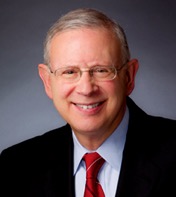
Dave pointed out that prior to LeBlanc's arrival there had only been 5 enforcement actions greater than $5M none of which was over $25M, but that since he arrived at EB there have been another 5 over $5M and one of them involved $100M! Dave has been quoted as saying at the conference that FCC has become "much, much more aggressive on enforcement”.
Too aggressive on enforcement?
Let's note that these actions all deal with Title II issues. EB was created to manage all FCC's enforcement work and to give them rational priorities. This is a spectrum blog and so let's review what today's EB has been doing with technical spectrum policy enforcement. The field staff downsizing is an obvious feature. Although increased productivity has been promised, there is no sign of the equipment, travel, training, and overtime funding needed to make that happen.
The consultant's report that was leaked revealed EB's priorities:
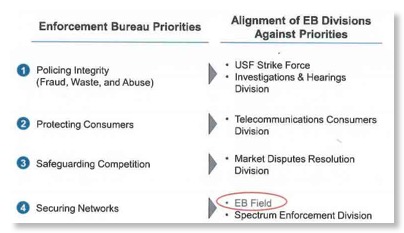
From Sunset Park, Fri. at ~4:55pm, many of the usual suspects seemed to be off the air, but 91.3 & 95.9 were on, w/preaching in English. We were on a hill w/view of NJ skyline & could also hear an apparently NJ-based Haitian pirate at 102.1 FM, spaced awfully close to WFAN-FM. Around 5:30 p.m. Fri., some of the usual suspects like 90.9 and 91.7 started their broadcast day. Others like 89.3 & 89.7 were still dark. ...also 92.9, 94.3, 94.5, 95.1, 97.5, 97.7, 99.3, 99.7, 99.9, 101.5, 101.7, 102.1, 102.3, 103.1, 104.1, 107.1, 107.9, and possibly 104.7.
Note that spectrum and field issues are at the bottom of the list. The recent tweets below on pirate radio activity ion New York shows what results from such a low priority:
While your blogger was involved in 4 criminal prosecutions ( 2 satellite jamming, 1 air traffic control intrusion, and 1 maritime false distress) during his brief tour in EB's predecessor, the Field Operations Bureau, it is unclear if EB has ever been involved in a criminal Title III matter since its creation more than 20 years ago from the merger of both FOB and enforcement parts of other bureaus. While this is blamed on DOJ disinterest, one wonders what has changed so much since the creation of EB?
Note that when AT&T and Motorola were found to be involved in harmful interference to safety-related Terminal Doppler Weather Radars near airports that detect turbulence that can endanger aircraft, they got off with "voluntary payments" of $25k and $9k . (AT&T and Moto's legal fees for these matter surely dwarfed the pittance they paid for their guilt.!) While there have been several $100+k NALs for cellular jamming incidents, have anywhere near these amounts ever been paid by the guilty party? Have Chinese jammer manufacturers ever paid any of the $1M+ NALs issued to them? There are anecdotal reports that EB and the FCC bureaucracy have little attention span for collecting such NALs.
So maybe the problem is a misbalance of enforcement interest between Title II and Title III issues and too much of a focus on impressive press releases as opposed to actual compliance or even payment of penalties?
When FCC announced the downsizing of spectrum enforcement, CTIA, NAB, and APCO complained and managed to get promises that their specific enforcement areas would not be ignored, but the overall plan changed little other than these promises. There is little assurance that the remaining EB field staff will have access to equipment funding travel, and over time to do the job expected of them and promised to the 3 large associations.
The root cause of this downsizing was the FCC's desperate budget situation.
While Congress might not want FCC to have resources for controversial topics like "spectrum caps" and "net neutrality", perhaps the key trade associations should start exploring with OMB and appropriation committees some sort of "lock box" arrangement for basic FCC noncontroversial long term spectrum policy and enforcement funding for issues that have been bipartisan for decades?
Europe and Asia Propose Extending ITU Radio Regulations to 1000 GHz at WRC-19
US Silent
FCC stalled at 95 GHz

Our friends at the UK's PolicyTracker, a spectrum-focused newsletter with world wide coverage, have given us kind permission to reprint the article below by Toby Youell that first appeared on their website on October 2.
Radio Regulations may be extended up to 1000 GHz at WRC-19
Two proposals for new agenda items at WRC-19 could lead to the Radio Regulations extending the upper limit for transmissions from 275 GHz to as much as 1000 GHz.
These frequencies are currently only governed by a footnote (5.565) that allows for the protection of receive-only applications such as the radio astronomy, Earth exploration satellite and space research services.
But according to a new proposal from the Asia Pacific Telecommunity, the ITU-R should “study potential candidate frequency bands for use of the land mobile and fixed services” between 275 GHz and 1000 GHz. Similarly, Europe's common proposal for agenda items at WRC-19 invites the ITU-R to “identify candidate frequency bands for use by systems in the land mobile and fixed services” in bands up to 450 GHz.
Gerlof Osinga, vice chairman of the European (CEPT) conference preparatory group, told a recent ITU inter-regional workshop on WRC-15 preparation that the 450 GHz limit was intended to limit the amount of work that would need to be done in the next study cycle.
According to both draft resolutions, using frequencies higher than 275 GHz may become viable as technology develops. Ultra-high-speed data communication systems demonstrated by some research and development organisations can already transmit at a speed of 100 Gbps above 275 GHz, CEPT says. IEEE task group 802.15.3d is developing standards for wireless personal area networks (WPANs) at these frequencies. One use case could be wireless links in data centres.
Initial studies of technical and operational characteristics of services operating in the 275–1000 GHz range have been undertaken by ITU-R Working Party 1A, while ITU-R Study Group 3 has studied the propagation characteristics of these bands. But according to documents submitted for WRC-15, sharing and compatibility between passive services and potential active applications in the bands has not yet been studied at ITU level.•
In view of the pending "Spectrum Frontiers" NPRM at FCC, why can't FCC think beyond the present 95 GHz upper limits of FCC radio service rules - a limit that was reached in 2003.
Discussions with FCC/IB staff have confirmed there is nothing comparable to this in US proposals. Does this indicate a structural flaw in US WRC preparation process? We think so as this is not the first time that US WRC proposals have focused in cliques well represented in WRC preparation and ignored other public interest issues. More later.
UPDATE
The CEPT and APT proposals for new spectrum beyond the present 275 GHz ITU limits can be downloaded here.
Chairman Wheeler, tear down that wall!
What will it take for FCC to break the 95 GHz ceiling in the "Spectrum Frontier" NPRM?

On October 16, 2003 in the Report and Order of Docket 02-146, FCC raised the upper limit of its radio service rules to 95 GHz. They have remained there ever since. The table below from the FCC Allocation Table, §2.106, shows the spectrum allocations and service rules from 86 to 105 GHz. Note the orange circle we have added to emphasize the lack of rules above 95. (Actually there are two small and narrow exceptions: amateur radio use and ISM use.)
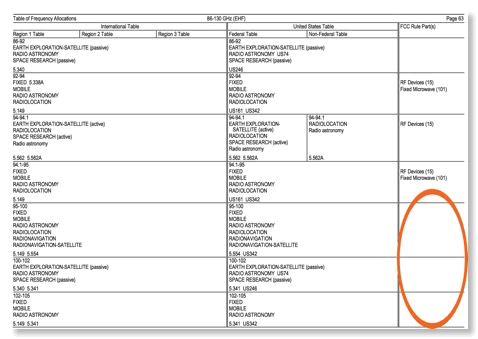
Chairman Wheeler last week announced "rebranding" the Docket 14-177 NOI in a "Spectrum Frontiers" NPRM that will be considered at the 10/22 Commission meeting. He stated:
This NPRM proposes a framework for flexible spectrum use rules for bands above 24 GHz, including for mobile broadband use. Promoting flexible, dynamic spectrum use has been the bedrock that has helped the United States become a world leader in wireless.
We are leveraging regulatory advances and propose to use market-based mechanisms that will allow licensees to provide any service – fixed, mobile, private, commercial, and satellite – depending on the band, and allow unlicensed uses to continue to expand. We are proposing to create a space that leverages the properties of this high band spectrum to simultaneously meet the needs of different users.
We hear from usually reliable sources that the NPRM will follow the NPRM and ignore the comments in keeping the bands considered under 95 GHz. In an August statement Chmn. Wheeler wrote
Our sources report nothing has changed. Furthermore despite the phrase "for a wide variety of users" the NPRM is expected to focus on the needs of CTIA members. We do not think it is inappropriate to provide new spectrum for such carriers, even though many are frankly ambivalent. (VZW did not even bother to file reply comments.) But what about other possible users?The spectrum bands proposed by the United States to be studied for consideration at WRC-19 include 27.5-29.5 GHz, 37-40.5 GHz, 47.2-50.2 GHz, 50.4-52.6 GHz, and 59.3-71 GHz. We will consider these bands, or a subset of the bands, in further detail in an upcoming NPRM, with the goal of maximum use of higher-frequency bands in the United States by a wide variety of providers.
What about broadband fixed links between locations where fiber installation is very expensive? (The fiber and electronics for fiber optic systems are inexpensive leading to a low cost/bit/mile if you exclude installation cost. But in urban environments installation costs can be huge for new fiber.) Millimeterwave fixed systems can serve such applications with a higher hardware cost, but lower total cost than fiber optics. Yet they face the same 95 GHz barrier!

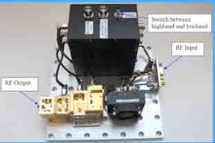

Why not also remove regulatory uncertainty from the manufacturers who are providing gray market equipment for non communications uses such as Terahertz spectroscopy? For example at left is a 575-560 GHz source sold by a US firm for THz spectroscopy and at the right is a Japanese system for use at 60 - 4000 GHz. These exist in a Title III "Never Never Land" with respect to their legality. Clearly they are not a target of the rapidly shrinking spectrum enforcement operation at FCC, but any investor doing due diligence would be thoroughly puzzled about the regulatory status of such technology. Such uncertainty is a disincentive to private capital formation which may explain why the more elegant device above comes from a Japanese firm.
In recent months ETSI, a nominal "standards organization" that includes most European counterparts of FCC, released the above report which is basically a master plan for millimeter wave development by Europe, Inc. while FCC stalls at 95 GHz. The applications considered in the ETSI report include both those of cellular carriers and other applications. They do not have tunnel vision focused solely on the needs of CTIA's European counterparts and spectrum below 71 GHz. (Does the Commission remember that in 1985 all the key industry players all opposed the Docket 81-413 rulemaking that is now the basis of both Wi-Fi and Bluetooth?)
Indeed, if FCC is at a loss what to do, maybe it should just propose endorsing the ETSI report? This would significantly reduce regulatory risk for US entrepreneurs!
Both the FCC's Asian and European counterparts, APT and CEPT, are proposing for WRC-15 new agenda items for WRC-19 that would go far beyond FCC's present technological meekness. APT proposes to "study potential candidate frequency bands for use of the land mobile and fixed services” between 275 GHz and 1000 GHz while CEPT proposes to “identify candidate frequency bands for use by systems in the land mobile and fixed services” in bands up to 450 GHz. FCC just can think beyond 95 GHz! Why?




![Validate my RSS feed [Valid RSS]](valid-rss-rogers.png)

